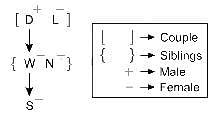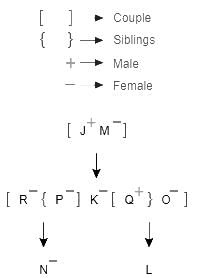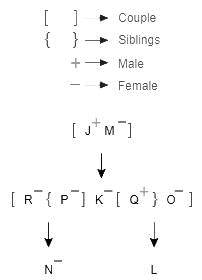MCQ: Blood Relations - 3(Hard) - SSC CGL MCQ
15 Questions MCQ Test General Intelligence and Reasoning for SSC CGL - MCQ: Blood Relations - 3(Hard)
Direction: Read the given instructions carefully and answer the questions given beside-
A = B means A is the Husband of B
A - B means A is the mother of B
A / B means A is the daughter of B
A % B means A is the son of B
A # B means A is the father of B
A @ B means A is the brother of B
A * B means A is the wife of B
A + B means A is the sister of B
If the given instruction ‘’L @ B @ K – N @ S + T % X’’ is true, then how is X related to L?
A = B means A is the Husband of B
If the given instruction ‘’L @ B @ K – N @ S + T % X’’ is true, then how is X related to L?
Direction: Read the given instructions carefully and answer the questions given beside-
A = B means A is the Husband of B
A - B means A is the mother of B
A / B means A is the daughter of B
A % B means A is the son of B
A # B means A is the father of B
A @ B means A is the brother of B
A * B means A is the wife of B
A + B means A is the sister of B
If the given instruction ‘’P = Q - R @ S = T - U + V = W’’ is true, then how is W related to S?
A = B means A is the Husband of B
| 1 Crore+ students have signed up on EduRev. Have you? Download the App |
Directions: Read the following information carefully and answer the questions given below.
A # B means A is the father of B
A % B means A is the mother of B
A @ B means A is the grandchild of B
A $ B means A is the mother-in-law of B
A * B means A is the sibling of B
’ A # C * E # G @ B $ D # I* H’, if D has only sons, then how H is related to E?
A % B means A is the mother of B
A @ B means A is the grandchild of B
A $ B means A is the mother-in-law of B
A * B means A is the sibling of B
Directions: Read the following information carefully and answer the questions given below.
A # B means A is the father of B
A % B means A is the mother of B
A @ B means A is the grandchild of B
A $ B means A is the mother-in-law of B
A * B means A is the sibling of B
According to the equation, who is the husband of N?
Equation: M # P # S @ R $ N * Q
Directions: Read the following information carefully and answer the questions given below.
A # B means A is the father of B
A % B means A is the mother of B
A @ B means A is the grandchild of B
A $ B means A is the mother-in-law of B
A * B means A is the sibling of B
Which of the following is true as per the equation?
Equation: P # Q % R * S @ T % Q
Directions: Read the given information carefully and answer the questions given beside.
A family is comprised of 11 members M, N, O, P, Q, R, U, V, W, X, and Y. It consists of three generations. If one of the parents is mentioned then both are alive. Some of the family members gave out the following statements.
W: P is my sister-in-law. I don’t have any siblings
Q: My wife is maternal grandmother of R, who is a male.
U: My spouse is M, who is the grandfather of V. I have only one sibling.
V: My paternal grandmother is the sibling of Q and is married to M, who has only 2 children of different genders.
X: N is my husband. My father is sibling of U.
P: Y is my aunt, who has a daughter. V is my nephew.
What is the relation of N with respect to Q?
Directions: Read the given information carefully and answer the questions given beside.
A family is comprised of 11 members M, N, O, P, Q, R, U, V, W, X, and Y. It consists of three generations. If one of the parents is mentioned then both are alive. Some of the family members gave out the following statements.
W: P is my sister-in-law. I don’t have any siblings
Q: My wife is maternal grandmother of R, who is a male.
U: My spouse is M, who is the grandfather of V. I have only one sibling.
V: My paternal grandmother is the sibling of Q and is married to M, who has only 2 children of different genders.
X: N is my husband. My father is sibling of U.
P: Y is my aunt, who has a daughter. V is my nephew.
Who among the following is the daughter-in-law of the person who is the sister-in-law of Y?
Directions: Read the given information carefully and answer the questions given beside.
A family is comprised of 11 members M, N, O, P, Q, R, U, V, W, X, and Y. It consists of three generations. If one of the parents is mentioned then both are alive. Some of the family members gave out the following statements.
W: P is my sister-in-law. I don’t have any siblings
Q: My wife is maternal grandmother of R, who is a male.
U: My spouse is M, who is the grandfather of V. I have only one sibling.
V: My paternal grandmother is the sibling of Q and is married to M, who has only 2 children of different genders.
X: N is my husband. My father is sibling of U.
P: Y is my aunt, who has a daughter. V is my nephew.
Four among the five pairs follows a same relationship. Find the odd pair out?
In a family of seven members A, B, C, D, E, F and G, there are three married couples. C is the daughter of B, who is the grandmother of E. F is the grandson of C, whose parents are A and B. E is married to G and has one son F. How is E related to B?
Directions: Study the following information carefully and answer the questions given below:
If P $ Q means P is the grand mother of Q
If P @ Q means P is the sister of Q
If P * Q means P is the husband of Q
If P & Q means P is the mother of Q
If P # Q means P is the son of Q
If P % Q means P is the daughter of Q
How N is related to S in the given expression ‘D * L & W @ N # L $ S % W '?
From which option, we can determine how many male members are there in the family?
Direction: Read the following information carefully and answer the questions given below :
Relations of a family consisting of J, K, L, M, N, O, P, Q, and R are given in a coded language using symbols. Study the following information and answer the questions given below.
P @ Q means P is father of Q
P # Q means P is mother of a Q
P $ Q means P is brother of a Q
P © Q means P is sister of a Q
P % Q means P is son of Q
P * Q means P is daughter of Q
J @ P * M, P © K © Q @ L, P # N % R, Q $ K, O # L
How is M related to R?
Direction: Read the following information carefully and answer the questions given below :
Relations of a family consisting of J, K, L, M, N, O, P, Q, and R are given in a coded language using symbols. Study the following information and answer the questions given below.
P @ Q means P is father of Q
P # Q means P is mother of a Q
P $ Q means P is brother of a Q
P © Q means P is sister of a Q
P % Q means P is son of Q
P * Q means P is daughter of Q
J @ P * M, P © K © Q @ L, P # N % R, Q $ K, O # L
How is N related to the husband of O?
Direction: Read the following information carefully and answer the questions given below :
Relations of a family consisting of J, K, L, M, N, O, P, Q, and R are given in a coded language using symbols. Study the following information and answer the questions given below.
P @ Q means P is father of Q
P # Q means P is mother of a Q
P $ Q means P is brother of a Q
P © Q means P is sister of a Q
P % Q means P is son of Q
P * Q means P is daughter of Q
J @ P * M, P © K © Q @ L, P # N % R, Q $ K, O # L
How is L related to K?
Directions: Study the following information carefully and answer the questions given below.
There are 10 members in a family. Each of them like different colour namely Black, Blue, Green, Grey, Indigo, Lime, Maroon, Orange, Pink, and Red, but not necessarily in the same order.
A likes black colour and married to D. I is the father of B, who likes Orange colour. F is the mother-in-law of H, who likes grey colour. E is the only child of C and G and likes green colour. The one who likes Maroon is the daughter-in-law of G. The one who likes lime is the father-in-law of the one who likes maroon. G does not like lime. H is the daughter-in-law of I, who likes blue colour. G is the daughter-in- law of A. C does not like maroon colour. A is the paternal grandfather of B. D does not like red colour. G likes pink.
Which of the following colour does the mother-in-law of J like?
|
177 videos|126 docs|197 tests
|
|
177 videos|126 docs|197 tests
|







































